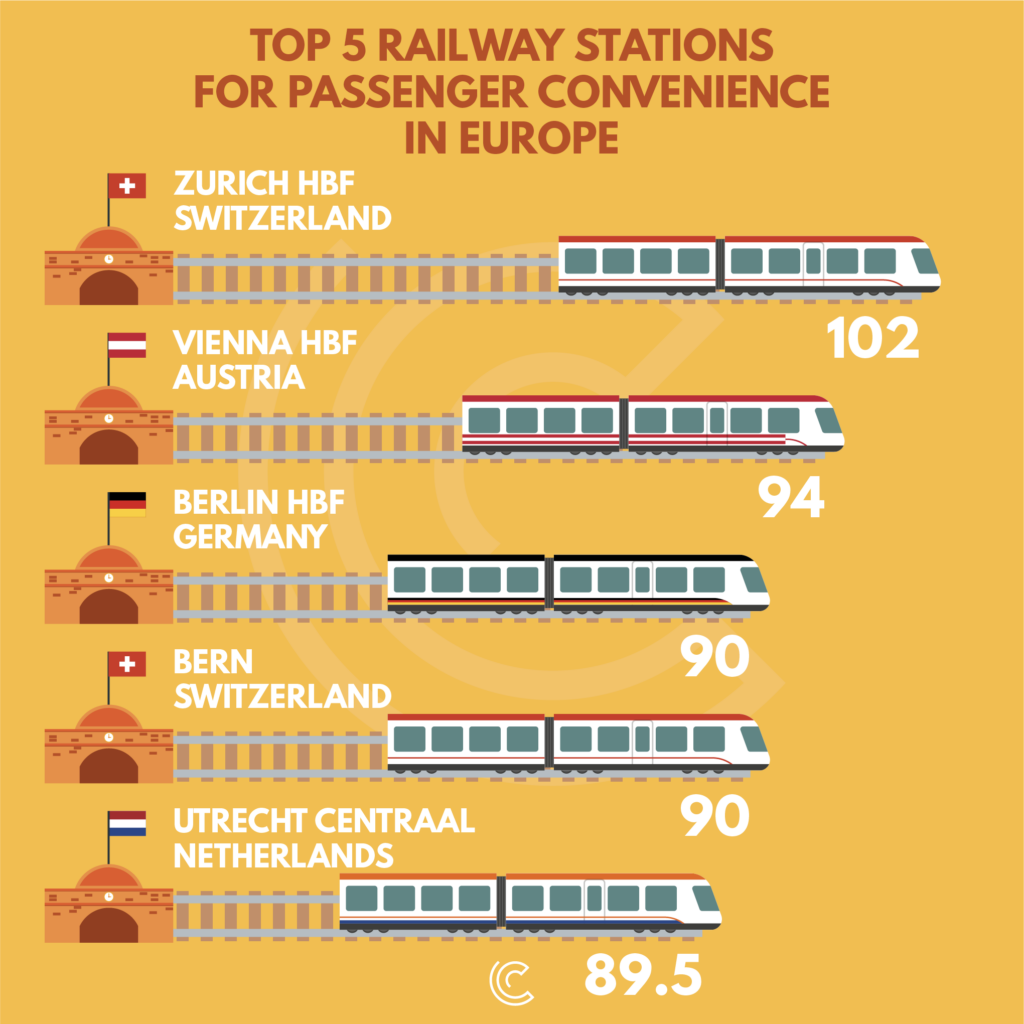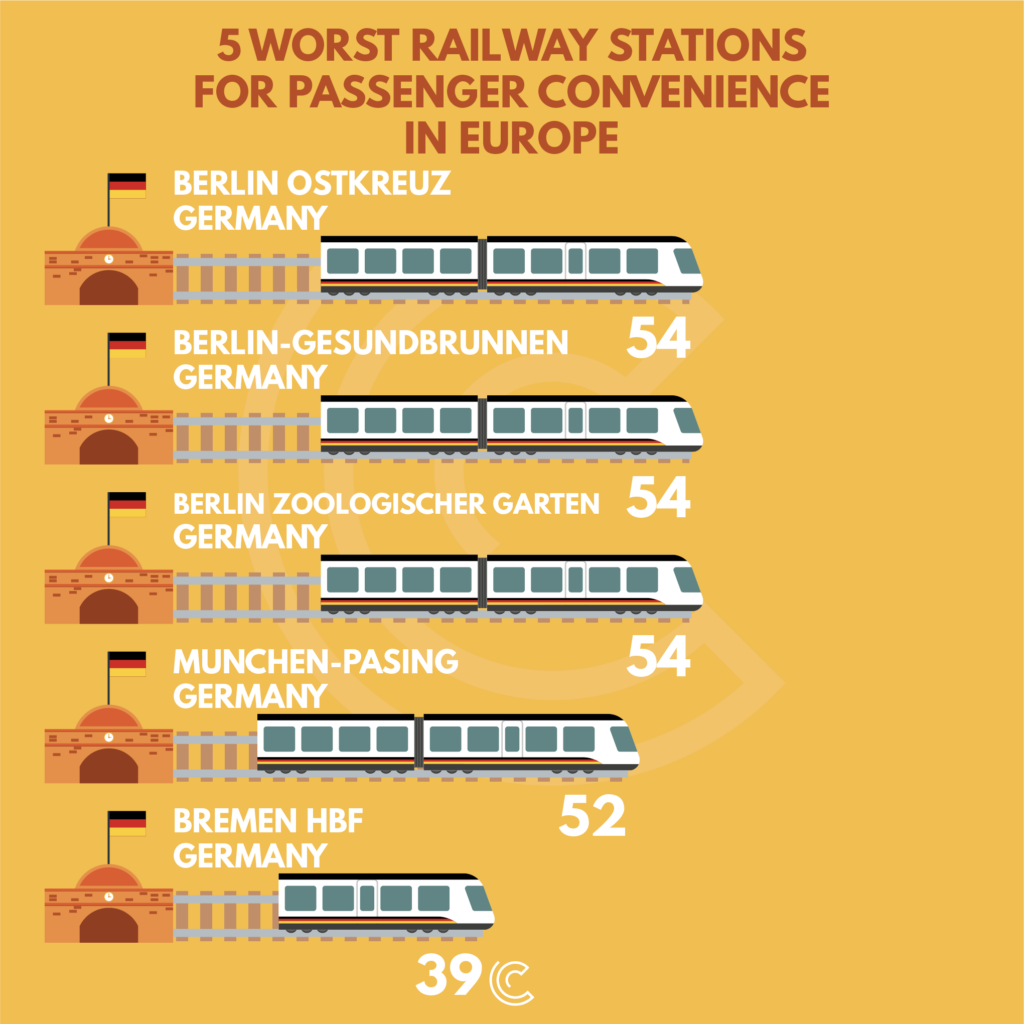- About Us
- Newsroom
- Research
- Policy Areas
- Podcasts
- Events
- Champs Night in Strasbourg
- Past Events
- Sweden is More Than Just IKEA
- The Path Forward: Liberal Democracies and Technology Policy
- Coping with uncertainty in a post-pandemic world
- FDA’s Menthol Melee: A CCC Session
- CANNABIS CONCLAVE BY CONSUMER CHOICE CENTER®
- Cannabis Conclave 2020
- Cannabis Conclave 2019
- Telecom and Media Innovation Summit
- Brand Freedom Day
- Media Roundtables: Does the WHO act
in the interest of Global Public Health?
- Donate

European Railway Station Index 2023
Introduction
As the world grapples with post-Covid recovery, railway stations are witnessing a complex blend of continuity and transformation. In the UK, passenger numbers are steadily rebounding, reaching 95% of pre-Covid levels after a significant 70% global drop. However, this surge has brought its challenges, such as severe train delays and longer waiting times. Specific factors unique to each country, like Germany’s subsidy program impacting stations like Munich, and the fallout from Russia’s invasion of Ukraine, with millions seeking refuge in Europe, further complicate railway congestion. Against this backdrop, we present the fourth annual European Railway Station Index, evaluating fifty major stations to guide consumers towards the best travel experiences amidst these changing realities.
About the research
We ranked fifty of Europe’s largest railway stations (measured in passenger volume) to help consumers pick the best station for their next journey while enjoying the best possible experience. We used several factors ranging from tickets to the number of in-station services, accessibility options, transport connections, free Wi-Fi, railway coverage, and ride-sharing.
Our fourth annual edition of the European Railway Station Index builds on our existing analysis using reports provided by national authorities, online statistics, station maps, real-time updates, and our own research. Passenger volumes reflect the latest available information. Besides the new stations added and the ones removed, we tried our best to include the extensive feedback we received last time. We improved the dataset based on meta-studies of consumer expectations, refining measures of density and coverage and adding more variables that passengers prioritize, like ticket types, apps, waiting times, and percentage of trains delayed.
Results
Both continuity and transformation describe the state of railway stations this year. Some of our strongest performers from previous indices continue to top our rankings – Zurich remains number one, and Berlin Central is in third place. In other respects, though, placements have changed radically since our last entry. Vienna’s Central Station, a newcomer to our dataset, is now in second place. Bern, an older tenant, is joint-third with Berlin Central. Vienna Meidling, the other new addition, is joint-tenth with Oslo Central in the index. Once in second place, Munich has dropped to the twenty-second position. Because of its lower passenger numbers (18,995,020 through 2022), London’s St. Pancras International did not make it into our top fifty.
Sadly, we tried but could not find sufficient information for Ukraine’s Kyiv-Pasazhyrskyi. Nevertheless, the resilience of Ukrainian railways in the face of Russian aggression (85% of trains ran on time in 2022 while under bombardment) continues to inspire us. We look forward to returning Kyiv and other entries to the dataset soon.


Benefits for Consumers
There are several upsides to choosing one of the top five stations for arrival or departure, such as less time spent waiting for trains, more convenient operating hours for ticket booths, more ticket packages to choose from, easier access to entrances, platforms, and restrooms for people using a wheelchair, more shops, kiosks, restaurants, and first-class lounges, better coverage, easier connections to and from the station, and less hassle traveling to other countries by train.
- Top 5 selections offer the best experience all around
- Central and Northern venues continue to provide convenient European connections compared to Southern and Eastern hubs.
- Stations have made more of an effort to accommodate those who require wheelchair access and to post signs and directions for people with disabilities – the scores for all stations improved in the category of accessibility.
- Consumers’ recent frustrations with railway services are not purely anecdotal but part of an observable depreciation in quality for most stations under current conditions.
Authors

Emil Panzaru
Research Manager

Amjad Aun
Fellow
Sign up Today
We will, from time to time, keep you updated on new and troublesome regulations in your country and ways that you can help use fight them. Don’t worry, being a member is always free!